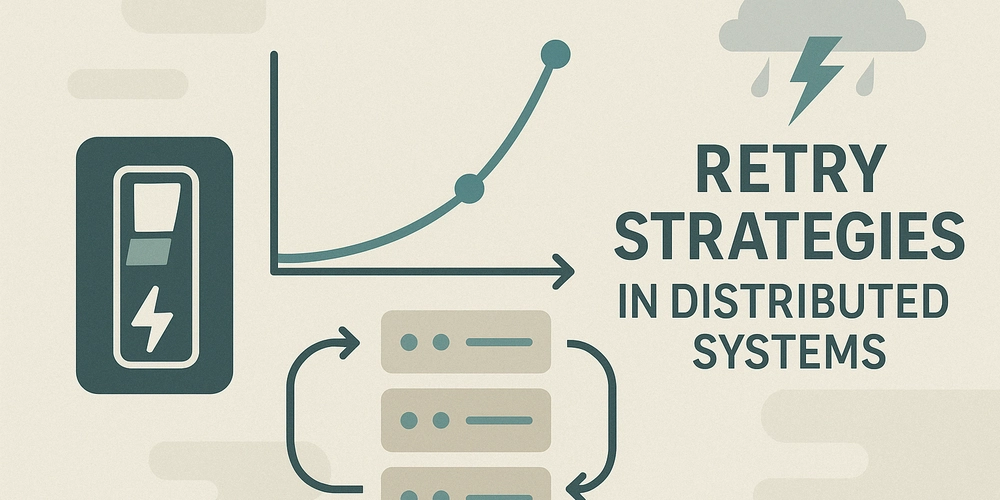Mastering Retry Strategies in Distributed Systems: Preventing Retry Storms and Ensuring Resilience
Humans instinctively retry when something fails—and distributed systems do, too. Retrying transient errors can dramatically boost end‑to‑end availability, but if left unchecked it can trigger cascading “retry storms” that amplify failures across deep call graphs and overwhelm downstream services. When to Retry (and When Not To) Retries are valuable for handling transient failures like brief network hiccups or temporary service overloads. However, you should not retry on: Client errors (4xx) such as malformed requests or authorization failures. 429 Too Many Requests when throttling or load‑shedding is intentional. Persistent downstream outages where retries simply add load without chance of success. The Availability Argument Consider a service that calls five downstream dependencies, each with 99.99% uptime. Without retries, the probability all succeed in one round is: Overall Availability = 1 – (1 – 0.9999)⁵ That yields only 99.95% end‑to‑end availability—below a 99.99% target. By allowing two retries per call, you effectively raise the total attempts to 7, which lifts availability above 99.99%, making retries often indispensable for strict SLAs. The Peril of Retry Storms In a deep call graph (e.g., A → B → C → D), a single retry at the top can fan out into exponential bursts—each layer multiplying retries—potentially generating hundreds of redundant calls that worsen an outage rather than resolve it. Patterns to Stop the Madness 1. Bounded Retries Cap the number of retries per time window or per operation to prevent runaway storms. Example: Allow up to 10 retries per minute, or grant “retry credits” proportional to successful calls. 2. Circuit Breaker Wrap calls in a circuit breaker that opens (halts retries) when failures exceed a threshold, half‑opens with probe requests, then closes when stability returns. This avoids hammering failing services. 3. AIMD (Additive Increase, Multiplicative Decrease) Adapt retry rate dynamically: increase retry allowance slowly on success, cut it sharply on failure. Borrowed from TCP congestion control, this feedback loop finds equilibrium without overload. 4. Exponential Backoff with Jitter Wait progressively longer between retries (e.g., 1s, 2s, 4s…) and add random “jitter” to spread retries over time, preventing synchronized spikes. 5. Server‑Side Guardrails Backpressure Contracts: Return a standardized “please retry later” response when overloaded, propagating retry metadata upstream. Load Shedding: Detect duplicates or drop excess work based on resource signals. Waste‑Work Avoidance: Honor client timeouts—abort processing if the caller has given up. Putting It All Together Classify errors and retry only transient failures. Bound retries at the client to SLA‑driven limits. Employ circuit breakers during downstream outages. Use jittered backoff to smooth traffic. Harden services with backpressure, load shedding, and waste‑work avoidance. With these patterns, you harness the availability benefits of retries without risking catastrophic retry storms. Always tailor parameters to your system’s failure modes and load patterns—and iterate using monitoring and chaos‑engineering experiments to continuously refine your retry policies.

Humans instinctively retry when something fails—and distributed systems do, too. Retrying transient errors can dramatically boost end‑to‑end availability, but if left unchecked it can trigger cascading “retry storms” that amplify failures across deep call graphs and overwhelm downstream services.
When to Retry (and When Not To)
Retries are valuable for handling transient failures like brief network hiccups or temporary service overloads.
However, you should not retry on:
- Client errors (4xx) such as malformed requests or authorization failures.
- 429 Too Many Requests when throttling or load‑shedding is intentional.
- Persistent downstream outages where retries simply add load without chance of success.
The Availability Argument
Consider a service that calls five downstream dependencies, each with 99.99% uptime. Without retries, the probability all succeed in one round is:
Overall Availability = 1 – (1 – 0.9999)⁵
That yields only 99.95% end‑to‑end availability—below a 99.99% target. By allowing two retries per call, you effectively raise the total attempts to 7, which lifts availability above 99.99%, making retries often indispensable for strict SLAs.
The Peril of Retry Storms
In a deep call graph (e.g., A → B → C → D), a single retry at the top can fan out into exponential bursts—each layer multiplying retries—potentially generating hundreds of redundant calls that worsen an outage rather than resolve it.
Patterns to Stop the Madness
1. Bounded Retries
Cap the number of retries per time window or per operation to prevent runaway storms.
Example: Allow up to 10 retries per minute, or grant “retry credits” proportional to successful calls.
2. Circuit Breaker
Wrap calls in a circuit breaker that opens (halts retries) when failures exceed a threshold, half‑opens with probe requests, then closes when stability returns. This avoids hammering failing services.
3. AIMD (Additive Increase, Multiplicative Decrease)
Adapt retry rate dynamically: increase retry allowance slowly on success, cut it sharply on failure. Borrowed from TCP congestion control, this feedback loop finds equilibrium without overload.
4. Exponential Backoff with Jitter
Wait progressively longer between retries (e.g., 1s, 2s, 4s…) and add random “jitter” to spread retries over time, preventing synchronized spikes.
5. Server‑Side Guardrails
- Backpressure Contracts: Return a standardized “please retry later” response when overloaded, propagating retry metadata upstream.
- Load Shedding: Detect duplicates or drop excess work based on resource signals.
- Waste‑Work Avoidance: Honor client timeouts—abort processing if the caller has given up.
Putting It All Together
- Classify errors and retry only transient failures.
- Bound retries at the client to SLA‑driven limits.
- Employ circuit breakers during downstream outages.
- Use jittered backoff to smooth traffic.
- Harden services with backpressure, load shedding, and waste‑work avoidance.
With these patterns, you harness the availability benefits of retries without risking catastrophic retry storms. Always tailor parameters to your system’s failure modes and load patterns—and iterate using monitoring and chaos‑engineering experiments to continuously refine your retry policies.










































































